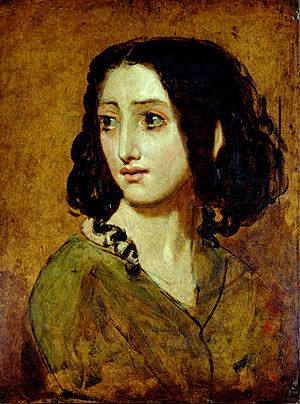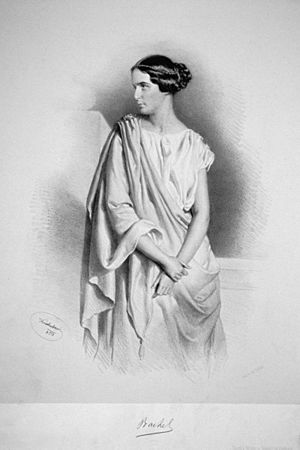Rachel Félix facts for kids
Quick facts for kids
Rachel Félix
|
|
|---|---|

Portrait of Mlle Rachel by William Etty, 1840s
|
|
| Born |
Elisabeth Félix
21 February 1821 |
| Died | 3 January 1858 (aged 36) |
Elisabeth Félix (born February 21, 1821 – died January 3, 1858) was a famous French actress. She was better known by her stage name, Mademoiselle Rachel. She became a very important person in French society during her time. After she died, newspapers tried to publish pictures of her on her deathbed. This led to new laws in France about privacy rights, which protect people's personal information.
Biography
Rachel Félix was born Elisabeth Félix on February 28, 1821. Her family was Jewish and lived in Mumpf, Rheinfelden, Aargau, Switzerland. Her father, Jacob Félix, was a traveling salesman. Her mother, Esther Hayer, sold used clothes. Rachel had four sisters named Sarah, Rebecca, Dinah, and Leah. She also had one brother named Raphael.
As a young girl, Rachel earned money by singing and reciting poems in the streets. In 1830, she moved to Paris, hoping to become an actress. She took lessons in speaking clearly and singing. Later, she studied with the musician Alexandre-Étienne Choron and a teacher named Saint-Aulaire.
She also took acting classes. Her first performance was in a play called La Vendéenne in January 1837. This was at the Théâtre du Gymnase. The director, Delestre-Poirson, gave her the stage name Rachel. She liked the name so much that she used it in her everyday life too.
Rachel was known for being a very serious and hardworking student. People admired her intelligence and her strong work ethic. She was also praised for her clear way of speaking and her acting skills. In March 1838, when she was just 17, she got a main role in Pierre Corneille's play Horace. She performed this at the Théâtre-Français.
Her fame quickly grew across Europe after she had great success in London in 1841. She often performed plays by famous writers like Racine, Voltaire, and Corneille. She also toured in other big cities like Brussels, Berlin, and St. Petersburg.
Even though French classical plays were not very popular when Rachel started acting, she stayed true to this style. She made audiences excited about the serious and dramatic plays of writers like Corneille, Racine, and Molière.
Rachel also created the main role in Eugène Scribe's play Adrienne Lecouvreur. Her acting was known for being very clear and not using too many big movements. She helped bring back a strong interest in classical tragedy plays. This was a big change from the overly dramatic acting styles common at the time. Rachel did not like the emotional and realistic "Romantic Drama" style that was popular in France. She was most famous for her role as the main character in Phèdre.
Later Life and Death
Rachel's health became worse after a long tour in Russia. She sadly passed away early in 1858, when she was 36 years old. She died from tuberculosis in Le Cannet, France.
Legacy
Before she died, Rachel wrote many farewell letters. She wrote to her sons, family, friends, and people she worked with at the Comédie-Française. She is buried in a special part of the Jewish section of Père Lachaise Cemetery in Paris. A street in Paris was also named after her.
The character "Vashti" in Charlotte Brontë's novel Villette was thought to be based on Rachel. Charlotte Brontë had seen Rachel perform in London.
A light brownish color, often used for face powder, is called "Rachel" after her. This color was popular for use in artificial light. A type of knitting machine, called the raschel machine, is also named after her.
Notable Roles and Tours
Rachel performed in many plays throughout her career. Here are some of her most important roles and tours:
- 1837: Her first play, La Vendéenne.
- 1838: She became famous playing Camille in Horace by Corneille. She also performed in Andromaque and Bajazet by Racine.
- 1839: She played Esther in Esther by Racine and Dorine in Tartuffe by Molière.
- 1840: She toured France for the first time, visiting cities like Rouen and Lyon.
- 1841: She toured in Belgium and England, which helped her become known across Europe.
- 1842: She played Chimène in Le Cid by Corneille.
- 1843: She became very famous for her role as the main character in Phèdre by Racine.
- 1844: She played the main role in Bérénice by Racine. Her first son, Alexandre, was born this year.
- 1846: She toured in the Netherlands and London.
- 1847: She performed in Athalie by Racine.
- 1848: Her second son, Gabriel, was born. She toured in Amsterdam.
- 1849: She played the main role in Adrienne Lecouvreur, a play written just for her.
- 1850: She toured many European cities, including Hamburg, Berlin, and Vienna.
- 1854: She toured in Warsaw, Saint Petersburg, and Moscow.
- 1855: She toured in the United States, including New York.
- 1858: Rachel passed away on January 3.
Images for kids
-
.
Rachel as Racine's Phèdre
See also
 In Spanish: Rachel Félix para niños
In Spanish: Rachel Félix para niños





